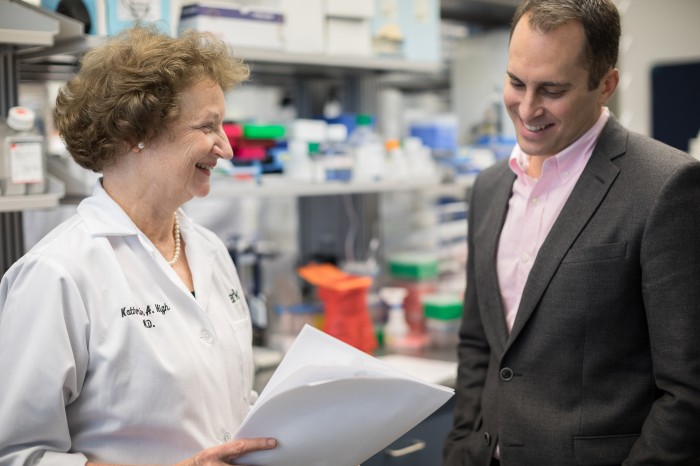FDA Vote Sets Stage for Gene Therapy’s Future

Up until five years ago, Allison Corona’s life was shrouded in darkness. Born with an inherited eye disorder called Leber congenital amaurosis, she could barely recognize colors and could only see the outlines of people—never their facial features or expressions. She says it was like living a half-life.
In 2012, she joined a clinical trial and received a life-changing experimental treatment called gene therapy. Now 25, she says the improvement in her vision has been “drastic.” Everything is brighter. She can see textures. She can tell whether her mother is happy or sad just by looking at her face.
The gene therapy Corona received is now one step closer to being available to more patients. On Thursday, an independent committee of experts voted 16-0 in a unanimous recommendation that the U.S. Food and Drug Administration approve the treatment, called Luxturna and made by Philadelphia-based Spark Therapeutics.
Luxturna was long expected to be the first gene therapy to reach the market in the U.S. But in August, a novel treatment that genetically modifies a patient’s own immune cells to fight cancer grabbed the title, becoming what the FDA called the “first gene therapy.” If approved, Luxturna would be the first treatment in the U.S. meant to fix an inherited genetic trait. The FDA must decide by January 12 whether to give it the green light.
So far, the therapy has shown remarkable results. More than two dozen children and adults have improved sight because of it. But questions remain about whether its effects are long-lasting and how much it will cost. An FDA document released earlier this week points out there’s no long-term data available. As for the price, one analyst’s prediction pegs it at around $400,000 per eye, and others estimate it could be as expensive as $1 million for both eyes.
For decades, gene therapy has been imagined as a way to treat—and potentially cure—serious genetic diseases (see “10 Breakthrough Technologies 2017: Gene Therapy 2.0”). The traditional idea of gene therapy is to use an engineered virus to deliver a healthy copy of a gene to a patient with a faulty version. The approach aims to correct disease at its genetic root instead of just ameliorating symptoms, as most medicines do.

Jeff Marrazzo, CEO of Spark Therapeutics, says Luxturna’s approval would mark a new era in medicine. “This is what I believe medicine is going to be like for the next 20, 30, if not 50 years,” he says. “I think this is the beginning of an age that is going to fundamentally change medicine.”
The company’s therapy is intended to fix a mutation in a gene called RPE65, which provides instructions for making a protein necessary for normal vision. Mutations in this gene cause Leber congenital amaurosis and other retinal disorders, including some types of retinitis pigmentosa.
The treatment works by shuttling billions of engineered virus particles carrying a correct copy of the RPE65 gene to a person's retinal cells. It’s injected directly into the eye in a quick procedure.
In a clinical trial, the gene therapy improved vision in 27 of 29 treated patients—or about 93 percent. Scientists tested participants’ vision by having them walk through an obstacle course in low light. A year after treatment, 21 of those treated—or 72 percent—were still able to navigate the course successfully.
Spark thinks about 6,000 people around the world will be eligible for its gene therapy, including 1,000 to 2,000 people in the U.S. Most of these patients would lose what little vision they have over time, eventually leading to complete blindness. There are no approved drugs for people with the genetic mutation.
A long time coming
Jean Bennett, a physician and scientist at the University of Pennsylvania who pioneered the gene therapy that would eventually become Luxturna, says Spark’s pending approval has been a long time in the making.
Bennett and her colleagues began research on gene therapy for inherited retinal diseases in the 1990s. They started with trying to figure out how to deliver lab-made DNA to the retinas of research dogs. It was in July 2000, Bennett recalls, that her team first treated three dogs with an early gene therapy they created.
“They had been extraordinarily timid and scared because they couldn’t see,” Bennett says. “Then after one eye was treated with a correct copy of the gene, their whole behavior changed. They started running around and playing. It was really obvious that there was a positive effect.”
Bennett and her colleagues were thrilled. But those early promising results were dampened by tragedy. The previous year, in 1999, an 18-year-old patient named Jesse Gelsinger had died in a gene-therapy experiment intended to treat his genetic liver disease. Then, in the early 2000s, children in a gene-therapy trial developed leukemia as a result of their treatment. The trial was stopped. Gene-therapy companies shut down. Bennett couldn’t get funding to continue the research.
“It was not a very popular time for gene therapy,” she says.
Finally, in 2005, she and her team partnered with investigators at Children’s Hospital of Philadelphia led by Katherine High, now the president and chief scientific officer of Spark Therapeutics. Bennett says High convinced the hospital to invest in gene-therapy research at a time when the field had chilled. The hospital hired researchers from companies that had folded and began clinical trials.
More good news came after safety studies showed that trial participants who received the eye therapy had few side effects. In 2013, Spark Therapeutics launched with $50 million from Children’s Hospital.
“I think from the very beginning, we were all convinced that this was going to work and that this was going to be safe. It’s so gratifying to get it to this point,” Bennett says.
Spark’s success has contributed to a revived interest in gene therapy. According to the Alliance for Cell and Gene Therapy, an industry group, gene-therapy companies raised nearly $1.2 billion in the second quarter of 2017, a 56 percent increase from the same quarter in 2016. And 504 gene-therapy clinical trials are under way worldwide, including 34 in the most advanced stages of testing, according to the organization. Big Pharma companies are even interested in gene therapy now.
Stephen Rose, chief research officer at the Foundation Fighting Blindness, which also supported early research on gene therapies for retinal diseases, says the approval of Spark's therapy would represent “a fruition of a long history.” He says it opens the door for other gene therapies that could eventually treat the more than 225 genetic mutations known to cause blindness.
Price concerns
Two gene therapies for other inherited diseases have already been approved in Europe: Glybera, for a rare metabolic disease, and Strimvelis, for a type of immune deficiency. Glybera has since been pulled from the market because of low demand (see “The World’s Most Expensive Medicine Is a Bust”). When the therapy was approved in Europe, its manufacturer, UniQure, set the price at a whopping $1 million.
Strimvelis, marketed by GlaxoSmithKline, costs 594,000 euros, or about $700,000, but comes with a money-back guarantee if patients aren’t cured.
After the FDA approved its first gene therapy, Kymriah, in August, maker Novartis set the price at $475,000. The company has justified the price by saying Kymriah is highly personalized and complex to manufacture. To create the therapy, which treats treat an often-lethal type of childhood leukemia, a patient’s own immune cells are extracted and genetically altered outside the body before being infused back into the patient. Novartis has said it won’t charge if the treatment doesn’t work within a month.
The high price of these other gene therapies suggests that Spark’s treatment will probably also be expensive, says Abdhish Bhavsar, a retinal specialist and clinical spokesperson for the American Academy of Ophthalmology.
“We have to be conscientious of the price,” he says. “I’m hoping it’s not unreachable to patients, because that would be unfortunate.”
Marrazzo has declined to say how much Luxturna will cost, but he says Spark is creating a program to substantially offset out-of-pocket costs to patients. This program will help pay for patients to travel to and stay near one of the about six U.S. centers where the therapy will be available, he says. Whether Luxturna will be covered by insurance companies isn’t yet known.
Whatever the price, the therapy wouldn’t be an outright cure. It doesn’t give patients 20/20 vision, and while it slightly improved some trial participants’ visual acuity, or sharpness, the improvement was not found to be statistically significant.
Scientists also don’t know how long Luxturna’s benefits last. The company has followed patients who received the gene therapy for only a few years.
Corona says she’s trying not to think about the possibility that the therapy could wear off. She feels that even if it does, the treatment will have been worth it.
“Even if I lose my vision when I’m older,” she says, “I got a couple of years that I wouldn’t have had.”
Editor’s note: This story was updated to include the FDA advisory panel’s recommendation on Luxturna.
Deep Dive
Biotechnology and health
How scientists traced a mysterious covid case back to six toilets
When wastewater surveillance turns into a hunt for a single infected individual, the ethics get tricky.
An AI-driven “factory of drugs” claims to have hit a big milestone
Insilico is part of a wave of companies betting on AI as the "next amazing revolution" in biology
The quest to legitimize longevity medicine
Longevity clinics offer a mix of services that largely cater to the wealthy. Now there’s a push to establish their work as a credible medical field.
There is a new most expensive drug in the world. Price tag: $4.25 million
But will the latest gene therapy suffer the curse of the costliest drug?
Stay connected
Get the latest updates from
MIT Technology Review
Discover special offers, top stories, upcoming events, and more.